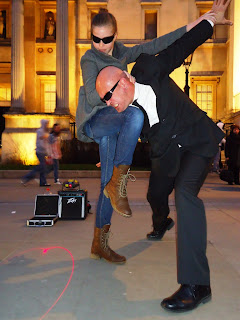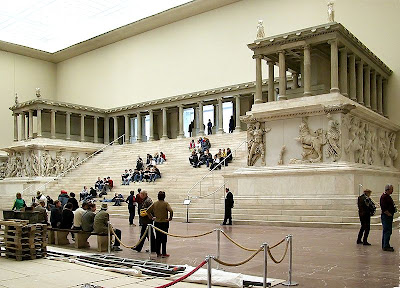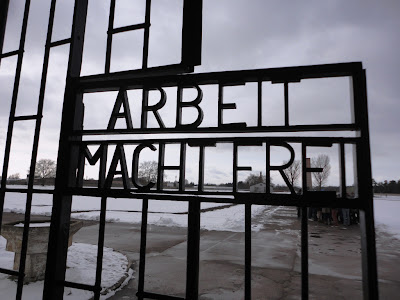Debbie and her husband, Gary, were very hospitable and a great help with offers of maps and suggestions and giving up a Sunday to take us to the extensive and very interesting Mauerpark markets. During our week stay we enjoyed some of Debbie's home cooking and Will did his intergalactically famous 'Devil's food cake'. We all went out to a typical German restaurant and Mark took the kids to a burger place in a former railway public toilet, via a night time walk through a drug dealer's park. Really. He did.
 |
| in a toilet. |

 |
| Not in a toilet. |
There is little evidence of pre War Berlin or the effects of the war. Towards the end of 1943, in an effort to break German resistance, British tactics changed and 'area bombing' was introduced in response not only to heavy bombing of London but also the perceived ineffectiveness of British bombing raids over Germany. B
omber command was taken over by Arthur Harris - later known as 'Bomber Harris
'. A controversial figure even during the war, Harris
deliberately focussed
on the heavy bombing of German cities, notably Hamburg in 1943 killing an estimated 40,000 people and more famously
Dresden in February 1945 which left between 25,000 to 35,000 dead.
The first heavy bombardments of Berlin started in late 1943. Commenting on the plans Harris said "It will cost us between 400 and 500 aircraft. It will cost Germany the war." Details of the early raids include the 22nd November 1943 raid which killed 2,000 Berliners and left 175,000 homeless. The next night 1,000 were killed and 100,000 were homeless. During December and January regular raids killed hundreds of people each night with between 20,000 and 80,000 made homeless each time. Overall the Berlin raids of 1943/4 alone left nearly 4,000 killed, 10,000 injured and 450,000 made homeless. The intense raids would often lead to massive fire-storms which, in some cases, burned for days on end.
Up to the end of March 1945 there had been a total of 314 air raids on Berlin, with 85 of those coming in the last twelve months. By the end of the war half of all houses in Berlin were damaged and around a third uninhabitable. As much as 16 km² of the city was simply rubble. Estimates of the total number of dead in Berlin from air raids range from 20,000 to 50,000. While massive, these figures are low compared to other German cities. Berlin's distance from England and its superior air defences and shelters saved more Berliners from the fate of their countrymen.
Mark last went to Berlin as part of a three month European tour with a friend from Uni in 1983. They went by train across Germany from west into east, crossing the border on the train into East Germany and then West Berlin. The border guards who entered the train to check documents were not to be taken lightly and there was certainly no 'Welcome to the GDR'. (When they left again by train a few days later the carriages was searched for escaping East Germans).
Back then the wall encircled the city and check point Charlie was still a real check point with serious guards on both sides. Crossing the border at Checkpoint Charlie was a bit of an ominous thing with very serious Soviet style East German guards, the compulsory changing of 100 west Deutchmarks into 100 worthless east marks artificially valued at 1:1. In the shops Mark & Cathy saw display windows filled with exotic western items, most commonly tinned pineapple. Despite those tempting displays, people were lining up to buy far more basic items. From what they saw, life in East Berlin was grim.
Now check point Charlie is a tourist attraction and evidence of the wall is hard to find.
Almost 10 years later further attempts were made to destroy it. As the Berlin Wall ran nearby the site was largely left ignored and undeveloped. In the 1980s, after re-unification, apartment blocks were built nearby and much of the site was filled in and covered over. Fearing it would become a neo- Nazi shrine, no markers were placed on the site until the 2006 Fifa World Cup when a modest sign outlining the plan of the bunker was put up. What is visited now is effectively just a car park for a block of flats. No evidence at all remains of what was there.


Berlin has quite literally hundreds of museums. While Aisha would have happily read very single explanation for every single exhibit in every museum, we decided to limit ourselves to just a few. In the end we saw just five over a couple of days. The Natural History museum, The Pergamon museum, The Topography of Terror, The New museum and The Museum of German History. All of them were excellent but, interestingly, not nearly as big as we had thought.
The Natural History museum was established in 1810 and has some of the world's best exhibits including the largest mounted dinosaur skeleton in the world, a Brachiosaurus. The skeleton is almost entirely a complete specimen found in Tanzania between 1909 & 1913. There is also one of only three specimens of archaeopteryx.


Aisha found some of her Tasmanian compatriots.
 |
A Tasmanian Tiger
from Aisha's birth state. |
 |
| Nice in a bolognese ! |
William found stuff too.

 The Pergamon Museum holds some amazing exhibits of recreated ancient buildings. In 1990 Mark went to Iraq and visited Babylon, just outside Baghdad. There he and his American travelling companion, Chris, saw the Iraqi reconstruction of the famed Ishtar gate of Babylon. At the time they were both suitably indignant to read that the originals had been hauled off to Berlin decades before. Just over 20 years latter it was astounding to stand in front of the rebuilt gate in Berlin.
The Pergamon Museum holds some amazing exhibits of recreated ancient buildings. In 1990 Mark went to Iraq and visited Babylon, just outside Baghdad. There he and his American travelling companion, Chris, saw the Iraqi reconstruction of the famed Ishtar gate of Babylon. At the time they were both suitably indignant to read that the originals had been hauled off to Berlin decades before. Just over 20 years latter it was astounding to stand in front of the rebuilt gate in Berlin.
The original was built in 575 BC by order of King Nebuchadnezzar II who also ordered the construction of the Hanging Gardens of Babylon and the destruction of the First Jewish Temple.
A model of the original may have looked.
The gate and processional way were dedicated to the Babylonian goddess Ishtar and constructed using glazed brick with alternating rows of bas-relief lions, dragons and aurochs. The roof and doors of the gate were of cedar, according to the dedication plaque. During the New Year's celebration statues of the gods were paraded through the gate and down the Processional Way.
Originally the gate, as part of the Walls of Babylon, was listed as one of the Seven Wonders of the world until it was replaced, in the 3rd century BC, by the Lighthouse of Alexandria.
Although only part of the Ishtar gates are reconstructed in Berlin what is on display is impressive.
 |
| W is impressed. |
 |
| Part of the Processional Way. |
The Pergamon museum was built in 1910. One of its main exhibits is the massive display of the rebuilt Pergamon altar. Pergamon was an ancient Greek city located in what is now eastern Turkey. The altar was built during the reign of King Eumenes II in the first half of the 2nd century BC on one of the terraces of the acropolis of Pergamon. It was excavated over 20 years from 1878 by German archaeologists. The altar is the first thing visitors see when they walk through the entrance hall. It is big.


The frieze that runs around the room depicts a battle between the gods and giants. Parts of it have been recreated in life sized sketches.


The museum also has a complete set of rooms from Aleppo in Syria. Taken from a christian house in the early 1900s, the painted walls date from the 1600s.


The museum was severely damaged during the air raids on Berlin at the end of the Second World War. Many of the pieces were stored safely away from the city while some of the larger pieces were walled in for protection. In 1945, the Red Army collected all of the loose museum items, either as war booty or to 'rescue' them from looting and fires then raging in Berlin. It wasn't until 1958 that most of the objects returned to East Germany. Significant parts of the collection remain in Russia however in the Pushkin Museum in Moscow and the Hermitage in Saint Petersburg.
Other exhibits at the Pergamon include reconstructions of a Roman market place from Miletus, again now in modern day Turkey. Built from marble in the 2nd century AD, it was largely destroyed by an earthquake in the 10th century. It was excavated in the 1900s and rebuilt in the museum. As so much of the market place was either in very small pieces or missing, large amounts of modern materials were controversially used.
We also went to the New Museum, principally to see Nefertiti. Originally built in 1843, the museum was completely destroyed during the war. Fortunately most of its treasures were already stored away in mine shafts at the start of the war. Reconstruction only started in 1986 and the new New Museum was opened in 2009.
Nefertiti lived around 1350 BC. She was the Great Royal Wife of Pharaoh Akhenaten who was the father of Tutankhamun - although Nefertiti was not his mother. Nefertiti and Akhenaten started a religious revolution, in which they worshipped one god only, Aten, or the sun disc.
Unlike when Mark saw her in 1983, this time photos weren't allowed but she was part of a fantastic exhibit opened only in December last year. The exhibit outlines who she was, her family line and also showing many other works of art of or dedicated to her. She is stunning, not just in the quality of the work but that she is now pretty much as she was when discovered in the excavations of an ancient workshop. Interestingly, it is unclear whether she is a finished piece or just a draft for a later work.

The last museum we saw was the German history museum. Unlike the others we saw this one could take days to see everything. It covered German history from pre Roman right through to post re-unification and EVERYTHING in between. Suffice to say we cruised through a lot of it - although for a while Aisha did try to read every label for every exhibit.
Having seen a lot of Australian and British exhibits on WWI & II it was fascinating to see the 'other side'. The museum did not shy away from the Nazi era nor the atrocities committed.
World War One recruiting posters.
 |
Post WWI hyperinflation
A 1 billion Deutsmark note |
World War Two posters
 |
| Not theatre costumes. |
 |
| A toy car with Hitler and friends. |
This Globe is reputed to have come from the office of Joachim von Ribbentrop who was the German foreign minister from 1938 - 1945. The bullet holes were made by soviet soldiers as they looted his office.

The Reichstag was opened in 1894 and served as the parliament building until it was set on fire in 1933. At the time the fire was widely reported to have been started by a Dutch communist. This gave the Nazis the pretext for suspending the Weimar constitution, to limit personal freedoms, increase state power and crack down on the communists across the country. The government started mass arrests of Communists, including all of the Communist parliamentary delegates. With them gone and their seats empty, the Nazis became the majority party. Subsequent elections confirmed this position and thus allowed Hitler to consolidate his power.
Whether it was really started by the Dutch communist (who was an intellectually disabled unemployed bricklayer later executed by guillotine for his crime) or by the Nazis themselves is still a matter of debate.
The building was never used by the Nazis as a parliament building as it remained in a state of disrepair after 1933 fire and subsequent air raids. Further damage was done during the Battle of Berlin in 1945, when it became one of the central targets for the Red Army to capture due to its perceived symbolic significance.
During its rebuilding, led by a British architect, the Reichstag was almost completely gutted. The large glass dome at the very top of the Reichstag, which was largely covered in snow when we visited , gives a 360-degree view of Berlin. Looing down from teh inner roof you can see directly into the main hall of the parliament. Integral to the design is th euse of natural light from the dome which radiates down to the parliament floor. A large sun shield tracks the movement of the sun electronically and blocks direct sunlight. Construction work was finished in 1999.
We were unlucky that the guided tours of the building were not operating for a couple of weeks when they were there but they were able to go up to the roof of the. It was a snowy day so the view was not a grand as it might otherwise have been.
 |
| Inside the roof. |
 |
| Looking down into the main hall. |
One visit I was uncertain about doing was to a concentration camp. Having been to Dacchau many year ago I knew how distressing they can be to visit. While we wanted the kids to have some understanding of what they were about, we did not want to upset them. In the end Mark decided to take then to Sachsenhausen-Oranienburg camp about an hour out of Berlin.
The camp was primarily used for political prisoners from 1936 through to the end of the war. It did of course imprison other groups including the disabled, homosexuals, gypsies and Jews. We spent most of a very sobering cold, snowy day there.
After 1945 the Soviets took it over and it was used to house Nazi war criminals as well as Soviet prisoners. It was finally closed as a working prison in 1950 but was still used by the Soviets as a military site up into the 60s.
 |
| The entrance to the camp. |
 |
| The snow covered remains of the huts. |
As this is published on 13th March, Sally heads to so some work in Madrid. Mark will join her on 14th and both will stay for the weekend. T Hey should be back on Sunday unless the Spanish strikes strand them there. The kids will be roaming the streets of London....or they might be going to Jane & Nigel's in Romsey. Who knows, it depends if they make it down to Waterloo station all by themselves.
Would someone call child services please !
For Easter we are planning on having two weeks in Ireland, both the Republic & Northern Ireland. The kids will do some surfing - because Ireland is well known for that sort of thing.






























+-+Copy.JPG)



















































